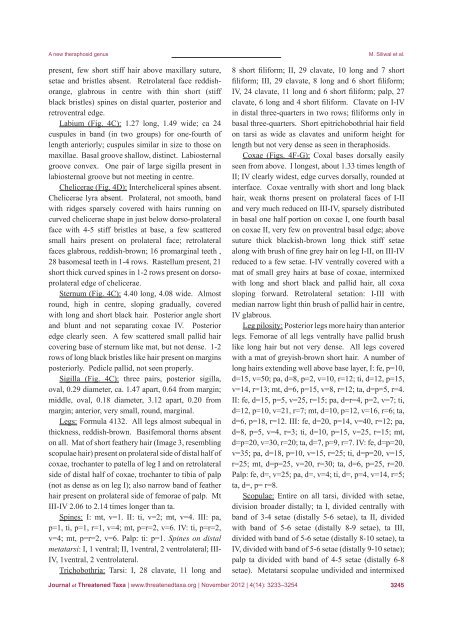View - Journal of Threatened Taxa
View - Journal of Threatened Taxa
View - Journal of Threatened Taxa
You also want an ePaper? Increase the reach of your titles
YUMPU automatically turns print PDFs into web optimized ePapers that Google loves.
A new theraphosid genuspresent, few short stiff hair above maxillary suture,setae and bristles absent. Retrolateral face reddishorange,glabrous in centre with thin short (stiffblack bristles) spines on distal quarter, posterior andretroventral edge.Labium (Fig. 4C): 1.27 long, 1.49 wide; ca 24cuspules in band (in two groups) for one-fourth <strong>of</strong>length anteriorly; cuspules similar in size to those onmaxillae. Basal groove shallow, distinct. Labiosternalgroove convex. One pair <strong>of</strong> large sigilla present inlabiosternal groove but not meeting in centre.Chelicerae (Fig. 4D): Intercheliceral spines absent.Chelicerae lyra absent. Prolateral, not smooth, bandwith ridges sparsely covered with hairs running oncurved chelicerae shape in just below dorso-prolateralface with 4-5 stiff bristles at base, a few scatteredsmall hairs present on prolateral face; retrolateralfaces glabrous, reddish-brown; 16 promarginal teeth ,28 basomesal teeth in 1-4 rows. Rastellum present, 21short thick curved spines in 1-2 rows present on dorsoprolateraledge <strong>of</strong> chelicerae.Sternum (Fig. 4C): 4.40 long, 4.08 wide. Almostround, high in centre, sloping gradually, coveredwith long and short black hair. Posterior angle shortand blunt and not separating coxae IV. Posterioredge clearly seen. A few scattered small pallid haircovering base <strong>of</strong> sternum like mat, but not dense. 1-2rows <strong>of</strong> long black bristles like hair present on marginsposteriorly. Pedicle pallid, not seen properly.Sigilla (Fig. 4C): three pairs, posterior sigilla,oval, 0.29 diameter, ca. 1.47 apart, 0.64 from margin;middle, oval, 0.18 diameter, 3.12 apart, 0.20 frommargin; anterior, very small, round, marginal.Legs: Formula 4132. All legs almost subequal inthickness, reddish-brown. Basifemoral thorns absenton all. Mat <strong>of</strong> short feathery hair (Image 3, resemblingscopulae hair) present on prolateral side <strong>of</strong> distal half <strong>of</strong>coxae, trochanter to patella <strong>of</strong> leg I and on retrolateralside <strong>of</strong> distal half <strong>of</strong> coxae, trochanter to tibia <strong>of</strong> palp(not as dense as on leg I); also narrow band <strong>of</strong> featherhair present on prolateral side <strong>of</strong> femorae <strong>of</strong> palp. MtIII-IV 2.06 to 2.14 times longer than ta.Spines: I: mt, v=1. II: ti, v=2; mt, v=4. III: pa,p=1, ti, p=1, r=1, v=4; mt, p=r=2, v=6. IV: ti, p=r=2,v=4; mt, p=r=2, v=6. Palp: ti: p=1. Spines on distalmetatarsi: I, 1 ventral; II, 1ventral, 2 ventrolateral; III-IV, 1ventral, 2 ventrolateral.Trichobothria: Tarsi: I, 28 clavate, 11 long andM. Siliwal et al.8 short filiform; II, 29 clavate, 10 long and 7 shortfiliform; III, 29 clavate, 8 long and 6 short filiform;IV, 24 clavate, 11 long and 6 short filiform; palp, 27clavate, 6 long and 4 short filiform. Clavate on I-IVin distal three-quarters in two rows; filiforms only inbasal three-quarters. Short epitrichobothrial hair fieldon tarsi as wide as clavates and uniform height forlength but not very dense as seen in theraphosids.Coxae (Figs. 4F-G): Coxal bases dorsally easilyseen from above. I longest, about 1.33 times length <strong>of</strong>II; IV clearly widest, edge curves dorsally, rounded atinterface. Coxae ventrally with short and long blackhair, weak thorns present on prolateral faces <strong>of</strong> I-IIand very much reduced on III-IV, sparsely distributedin basal one half portion on coxae I, one fourth basalon coxae II, very few on proventral basal edge; abovesuture thick blackish-brown long thick stiff setaealong with brush <strong>of</strong> fine grey hair on leg I-II, on III-IVreduced to a few setae. I-IV ventrally covered with amat <strong>of</strong> small grey hairs at base <strong>of</strong> coxae, intermixedwith long and short black and pallid hair, all coxasloping forward. Retrolateral setation: I-III withmedian narrow light thin brush <strong>of</strong> pallid hair in centre,IV glabrous.Leg pilosity: Posterior legs more hairy than anteriorlegs. Femorae <strong>of</strong> all legs ventrally have pallid brushlike long hair but not very dense. All legs coveredwith a mat <strong>of</strong> greyish-brown short hair. A number <strong>of</strong>long hairs extending well above base layer, I: fe, p=10,d=15, v=50; pa, d=8, p=2, v=10, r=12; ti, d=12, p=15,v=14, r=13; mt, d=6, p=15, v=8, r=12; ta, d=p=5, r=4.II: fe, d=15, p=5, v=25, r=15; pa, d=r=4, p=2, v=7; ti,d=12, p=10, v=21, r=7; mt, d=10, p=12, v=16, r=6; ta,d=6, p=18, r=12. III: fe, d=20, p=14, v=40, r=12; pa,d=8, p=5, v=4, r=3; ti, d=10, p=15, v=25, r=15; mt,d=p=20, v=30, r=20; ta, d=7, p=9, r=7. IV: fe, d=p=20,v=35; pa, d=18, p=10, v=15, r=25; ti, d=p=20, v=15,r=25; mt, d=p=25, v=20, r=30; ta, d=6, p=25, r=20.Palp: fe, d=, v=25; pa, d=, v=4; ti, d=, p=4, v=14, r=5;ta, d=, p= r=8.Scopulae: Entire on all tarsi, divided with setae,division broader distally; ta I, divided centrally withband <strong>of</strong> 3-4 setae (distally 5-6 setae), ta II, dividedwith band <strong>of</strong> 5-6 setae (distally 8-9 setae), ta III,divided with band <strong>of</strong> 5-6 setae (distally 8-10 setae), taIV, divided with band <strong>of</strong> 5-6 setae (distally 9-10 setae);palp ta divided with band <strong>of</strong> 4-5 setae (distally 6-8setae). Metatarsi scopulae undivided and intermixed<strong>Journal</strong> <strong>of</strong> <strong>Threatened</strong> <strong>Taxa</strong> | www.threatenedtaxa.org | November 2012 | 4(14): 3233–32543245

















